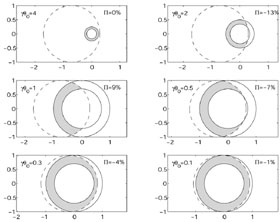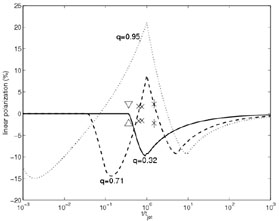


J. Afterglow Polarization - a tool that distinguished between the different jet models
Synchrotron emission from a jet (in which the spherical symmetry is broken) would naturally produce polarized emission [126, 147, 365]. Moreover, the level and the direction of the polarization are expected to vary with time and to give observational clues on the geometrical structure of the emitting jet and our observing angle with respect to it.
The key feature in the determination of the polarization during
the afterglow is the varying Lorentz factor and (after jet break)
varying jet width. This changes changes the overall geometry (see
Fig. 16) and hence the observer
sees different
geometries [177,
365].
Initially, the relativistic beaming angle 1 /
 is narrower than the
physical size of the jet
is narrower than the
physical size of the jet
 0, and the
observer see a full ring and therefore the radial polarization averages
out (the first frame, with
0, and the
observer see a full ring and therefore the radial polarization averages
out (the first frame, with

 0 = 4 of the
left plot in Fig. 30). As the flow decelerates,
the relativistic beaming angle 1 /
0 = 4 of the
left plot in Fig. 30). As the flow decelerates,
the relativistic beaming angle 1 /
 becomes comparable
to
becomes comparable
to  0 and only
a fraction of the ring is visible; net polarization is then
observed. Assuming, for simplicity, that the magnetic field is
along the shock then the synchrotron polarization will be radially
outwards. Due to the radial direction of the polarization from
each fluid element, the total polarization is maximal when a
quarter (
0 and only
a fraction of the ring is visible; net polarization is then
observed. Assuming, for simplicity, that the magnetic field is
along the shock then the synchrotron polarization will be radially
outwards. Due to the radial direction of the polarization from
each fluid element, the total polarization is maximal when a
quarter (
 0 = 2 in
Figure 30) or when
three quarters (
0 = 2 in
Figure 30) or when
three quarters (
 0 = 1 in
Figure 30) of
the ring are missing (or radiate less efficiently) and vanishes
for a full and a half ring. The polarization, when more than half
of the ring is missing, is perpendicular to the polarization
direction when less than half of it is missing.
0 = 1 in
Figure 30) of
the ring are missing (or radiate less efficiently) and vanishes
for a full and a half ring. The polarization, when more than half
of the ring is missing, is perpendicular to the polarization
direction when less than half of it is missing.
 |
 |
Figure 30. Top: Shape of the emitting
region. The dashed line marks the
physical extent of the jet, and solid lines give the viewable
region 1 / |
At late stages the jet expands sideways and since the offset of the observer from the physical center of the jet is constant, spherical symmetry is regained. The vanishing and re-occurrence of significant parts of the ring results in a unique prediction: there should be three peaks of polarization, with the polarization position angle during the central peak rotated by 90° with respect to the other two peaks. In case the observer is very close to the center, more than half of the ring is always observed, and therefore only a single direction of polarization is expected. A few possible polarization light curves are presented in Fig. 30.
The predicted polarization from a structured jet is drastically
different from the one from a uniform jet, providing an excellent
test between the two models
[348].
Within the structured jet model the polarization arises due to the
gradient in the emissivity. This gradient has a clear orientation.
The emissivity is maximal at the center of center of the jet and
is decreases monotonously outwards. The polarization will be
maximal when the variation in the emissivity within the emitting
beam are maximal. This happens around the jet break when
 obs ~
obs ~
 -1 and
the observed beam just reaches
the center. The polarization expected in this case is around 20%
[348]
and it is slightly larger than the
maximal polarization from a uniform jet. As the direction of the
gradient is always the same (relative to a given observer) there
should be no jumps in the direction of the polarization.
-1 and
the observed beam just reaches
the center. The polarization expected in this case is around 20%
[348]
and it is slightly larger than the
maximal polarization from a uniform jet. As the direction of the
gradient is always the same (relative to a given observer) there
should be no jumps in the direction of the polarization.
According to the patchy shell model
[206]
the jet can includes variable emitting hot spots. This could lead to a
fluctuation in the light curve (as hot spots enter the observed
beam) and also to corresponding fluctuations in the polarization
[133,
267].
There is a clear prediction
[267,
274]
that if the fluctuations are angular fluctuations have a typical angular
scale  f then
the first bump in the light curve should take place on the time
when
f then
the first bump in the light curve should take place on the time
when  -1 ~
-1 ~
 f (the whole
hot spot will be
within the observed beam). The following bumps in the light curve
should decrease in amplitude (due to statistical fluctuations).
Nakar and Oren
[267]
show analytically and numerically that the
jumps in the polarization direction should be random, sharp and
accompanied by jumps in the amount of polarization.
f (the whole
hot spot will be
within the observed beam). The following bumps in the light curve
should decrease in amplitude (due to statistical fluctuations).
Nakar and Oren
[267]
show analytically and numerically that the
jumps in the polarization direction should be random, sharp and
accompanied by jumps in the amount of polarization.